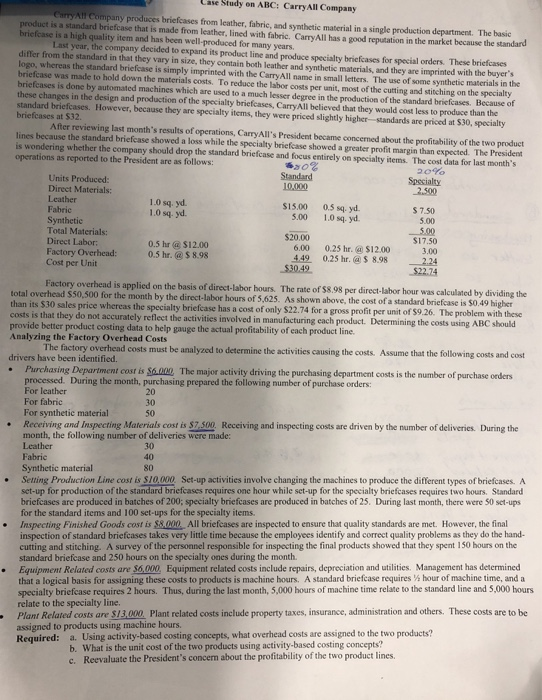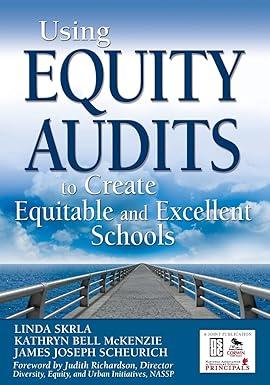Lase Study on ABC: Carry All Company y produces briefcases from leather, fabric, and synthetic material in a single production department. The basic product is a standard briefcase that is made from leather, lined with fabric. Carry All has a good reputation in the market because the standard briefcase is a high quality item and has been well-produced for many years Last year, the company decided to expand its product line and produce specialty briefcases for special orders. These briefcases differ from the standard in that they vary in size, they contain both leather and synthetic materials, and they are imprinted with the buyer's logo, whereas the standard briefcase is simply imprinted with the Carry All name in small letters. The use of some synthetic materials in the fease was made to hold down the materials costs. To reduce the labor costs per unit, most of the cutting and stitching on the specialty briefcases is done by automated machines which are used to a much lesser degree in the production of the standard briefcases. Because of these changes in the design and production of the specialty briefcases, Carry All believed that they would cost less to produce than the dard briefcases. However, because they are specialty items, they were priced slightly higher-standards are priced at $30, specialty rief After reviewing last month's results of operations, CarryAll's President became concerned about the profitability of the two product ing whether the company should drop the standard briefcase and focus entirely on specialty items. The cost data for last month's lines because the standard briefcase showed a loss while the specialty briefcase showed a greater profit margin than expected. The President operations as reported to the President are as follows: Standard 10,000 Specialty Units Produced: Direct Materials $15.00 0.S sq.yd. S 7.50 5.00 1.0 sq. yd. nthetic Total Materials: Direct Labor Factory Overhead: Cost per Unit $20.00 $17.50 3.00 0.5 hr@ $12.00 0.5 hr.@ $ 8 6.00 449 0.23 hr.@ $12.00 0,25 hr. a $ 8.982.24 $22.74 pplied on the basis of direct-labor hours. The rate of $8.98 per direct-labor hour was calculated by dividing the total overhead $50,500 for the month by the direct-labor hours of 5.625. As shown above, the cost of a standard briefcase is $0.49 higher than its $30 sales costs is that they do not accurately reflect the activities involved in provide better product costing data to help gauge the actual profitability of each product line Analyzing the Factory Overhead Costs es price whereas the specialty briefease has a cost of only $22.74 for a gross profit per unit of $9.26. The problem with these manufacturing each product. Determining the costs using ABC should The factory overhead costs must be analyzed to determine the activities causing the costs. Assume that the following costs and cost drivers have been identified. . Purchasing Department cost is $6 000 The major activity driving the purchasing department costs is the number of purchase orders processed. During the month, purchasing prepared the following number of purchase orders: For leather For fabric For synthetic material 20 30 Receiving and Inspecting Materials cost is $7,500. Receiving and inspecting costs are driven by the number of deliveries During the month, the following number of deliveries were made: Leather 30 40 80 Synthetic material . Setting Production Line cost is S10.000 Set-up activities involve changing the machines to produce the different types of briefcases. A set-up for production of the standard briefcases requires one hour while set-up for the specialty briefcases requires two hours. Standard briefcases are produced in batches of 200; specialty briefcases are produced in batches of 25. During last month, there were s0 set-ups for the standard items and 100 set-ups for the specialty items Inspecting Finished Goods cost is $8.000 All briefcases are inspected to ensure that quality standards are met. However, the final inspection of standard briefcases takes very little time because the employees identify and correct quality problems as they do the hand- cutting and stitching. A survey of the personnel responsible for inspecting the final products showed that they spent 150 hours on the standard briefcase and 250 hours on the specialty ones during the month. .Equipment Related costs are $6,00O Equipment related costs include repairs, depreciation and utilities. Management has determined hour of machine time, and a specialty briefcase requires 2 hours. Thus, during the last month, 5,000 hours of machine time relate to the standard line and $,000 hours Plant Related costs are $13.000 Plant related costs include property taxes, insurance, administration and others. These costs are to be that a logical basis for assigning these costs to products is machine hours. A standard briefcase requires relate to the specialty line Required: a. Using activity-based costing concepts, what overhead costs are assigned to the two products? b. What is the unit cost of the two products using activity-based costing concepts? c. Reevaluate the President's concern about the profitability of the two product lines







